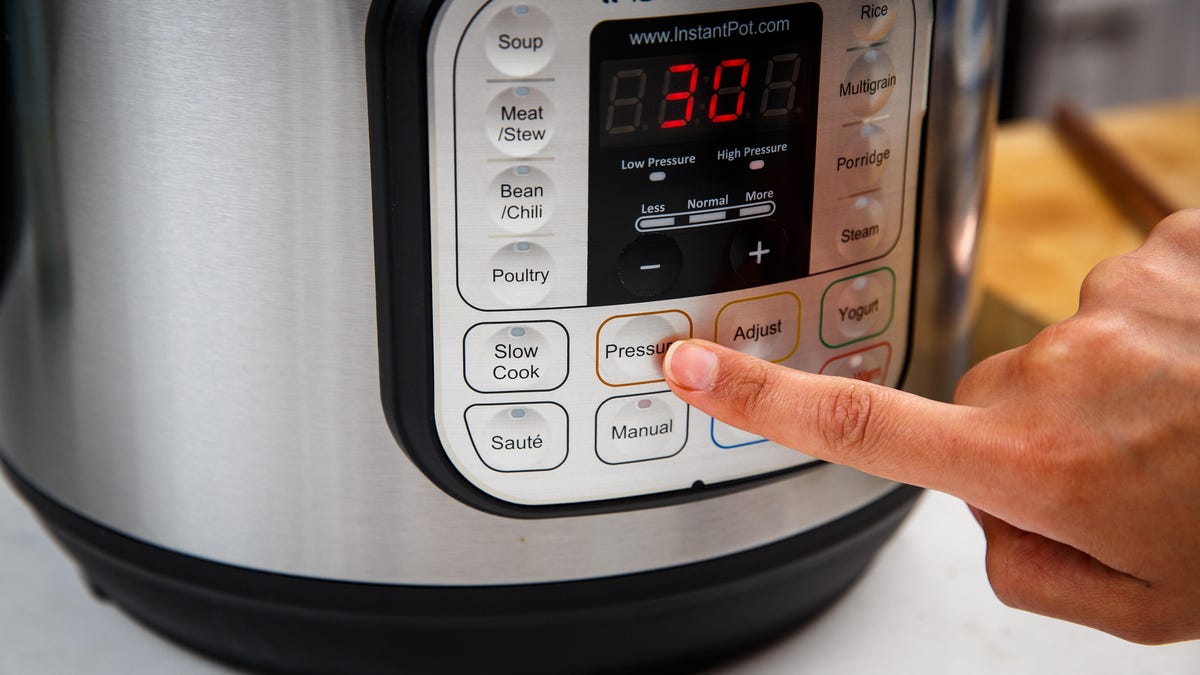What all the buttons on your Instant Pot mean
Just press a button and go? Not so fast!

Many of the Instant Pot buttons may seem self-explanatory with just a few on the iffy side, but trust me, all is not what it seems. Most of them need to be combined with other buttons for a proper cook. Here's what you need to know.
Read more: The complete guide to your Instant Pot
Plus and Minus
You'll notice that your Instant Pot has a Plus and Minus button in the very center. These are probably the most used keys, as you'll see below. You use the Minus button to lower cooking times and the Plus button to add time after you press a program key like Rice, Chili or Soup.
Above the Plus and Minus buttons is a display with three lights marked Less, Normal or More. Pushing the Minus button to get the Less mode to turn on and the Minus button to get to the More mode doesn't work. Instead, press the program button repeatedly.
Soup/Broth, Meat Stew and Chili Buttons
The Soup/Broth, Meat Stew, and Chili buttons are pretty obvious, but you can combine them with the Plus and Minus buttons to get cooking greatness.
For example, if you're cooking soup without meat, press the Soup/Broth button and the Minus button to start the Less mode. If you're cooking rich bone broths, press the Soup/Broth button until the More mode lights up.
With the Meat Stew button, start up the Less mode to give the meat a soft texture with some chew to it or the More mode if you want fall-off-the-bone texture.
The same goes for the chili button. If you want your beans a little stiffer, reduce the cooking time. If you want your beans extra soft, ramp it up.
Poultry
This button will get birds cooked to perfection, as long as you know how you want them cooked. Like with stews, you can add more cooking time to make the meat fall-off-the-bone tender, or choose less time for a chewier texture.
Porridge and Steam
With the Porridge and Steam buttons, you push the Plus or Minus button as well as the program button depending on what you're cooking.
If you're cooking white rice porridge, then you're good to go with just pushing the Porridge button. On the other hand, if you're cooking oatmeal, press the Porridge button to set the Less mode. If you're cooking congee with rice and beans, you'll need to press the Porridge button to set the More mode for a longer cooking time.
Similarly, if you're steaming fish and seafood, just push the Steam button. If you're cooking vegetables, use the Less mode, and if you're steaming meat, use the More mode.
Rice and Multigrain
Using the Rice and Multigrain buttons are similar to Porridge and Steam. If you're cooking white rice, you can simply press the Rice button. It's automatic, no need for the Plus or Minus buttons. If you're cooking brown rice or wild rice, though, you'll need to press the Multigrain button. Rice cooked using the Multigrain button will end up al dente if you use the Less mode and will be extra soft if you use the More mode.
Saute
Saute works just like sauteing in a pan. It browns meats and can precook vegetables to enhance their flavors in soups, stews and chilis. You can also use it to thicken sauces by using the Less mode or stir fry by using the More mode.
Yogurt
When making yogurt, you don't just hit the corresponding button and walk away. First, you'll need to pasteurize the milk by pressing Yogurt to the More mode. Then, press the Yogurt button to ferment the milk. Only press Yogurt and the Minus button if you want to make Jiuniang.
Slow Cook
If you didn't already guess, this basically slowly cooks whatever you put in your pot. Slow cooking can make meat more tender or give foods time to cook while you're at work.
For the best results, after pressing the Slow Cook button, put it on Less mode for warm heat or More mode for high heat, according to your recipe. Just pressing the Slow Cook button will give you a low heat setting that is comparable to the Low setting on a slow cooker.
Pressure Level and Pressure Cook
Pressure cooking is exactly what it sounds like. The Instant Pot boils liquid added to the pot to create pressure. This pressure cooks foods faster than other cooking methods. It also keeps meats moist during the cooking process.
To start pressure cooking, simply press the corresponding key. The Pressure Level button switches the pressure level between low and high. You'll need this button to regulate the pressure amounts as directed by your recipes. Then, use the Plus and Minus buttons to adjust the timer.
Delay Start
Want to wait before you start cooking? Press any of the program buttons like you normally would, then press the Delay Start button. Use the Plus and Minus keys to enter the amount of time you want to wait. When the time runs out, the Instant Pot will start cooking using whatever cooking information you programmed into it.
Keep Warm
You typically won't need to press this button. The warming mode comes on automatically during all programs except Yogurt and Saute. You do have the option of turning the Keep Warm function on or off by simply pressing the button after you choose the program.
Don't forget, Instant Pot remembers
After putting in your Plus or Minus button preferences, the Instant Pot will remember and use them next time you push Soup, Stew, Chili or whatever. So don't adjust the time unless you didn't like how your last dish turned out.

